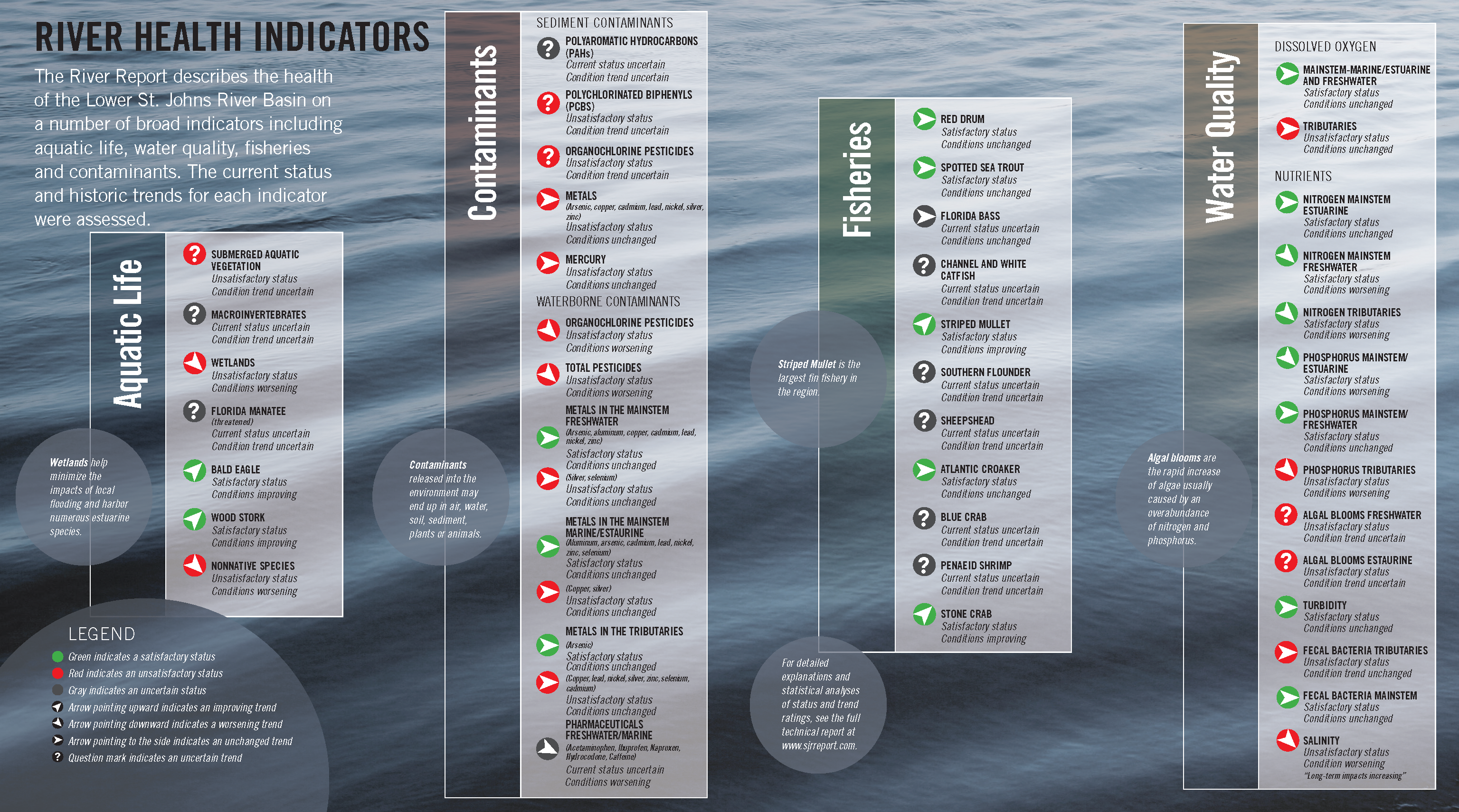Welcome to the Lower St. Johns River Basin “State of the River” Report.
The State of the River Report is a collaborative effort by a team of academic researchers from Jacksonville University, University of North Florida, Jacksonville, FL; and Penn State Berks, Reading, Pennsylvania. The report is supported by the Environmental Protection Board of the City of Jacksonville. The purpose of the project is to review data and literature about the river and to present it in a format readable to the general public. The report consists of four parts: the website, the brochure, the full report, and an appendix. The brochure provides a brief summary of the status and trends of each indicator (i.e., water quality, fisheries, etc.), and the full report and appendix contain the full background, analysis, and status and trend evaluation. Many different sources of data are examined, including data from the Florida Department of Environmental Protection, St. Johns River Water Management District, Fish and Wildlife Commission, City of Jacksonville, individual researchers, and others. The most statistically rigorous and stringent research available is used to assemble the report. An extensive peer review of the draft report is undertaken each year to ensure accuracy, balance, and clarity.
Executive Summary
The Seventeenth State of the River Report is a summary and analysis of the health of the Lower St. Johns River Basin (LSJRB) available at http://www.sjrreport.com. The Report addresses four main areas of river health: water quality; fisheries; aquatic life; and contaminants. This year’s findings indicate the need for concern in many aspects of the health of the River.
- Fecal indicator bacteria levels in the tributaries are an ongoing concern. The 2022-24 FDEP biennial assessment reveals that 49 tributaries in the basin are impaired. For 41 of these, the source of contamination is confirmed to be human by chemical tracers or genetic markers. Failing septic tanks are a key contributor, and septic tank phase-out projects are advancing in three Jacksonville neighborhoods: Biltmore, Beverly Hills, and Christobel.
- Salinity continues to rise in several reaches of the basin, due to both natural phenomena and human activities, including sea level rise. Although there is no regulatory target for salinity, considering salinity impacts of human and natural phenomena is critical for a healthy river ecosystem.
- Submerged aquatic vegetation (SAV) has undergone a long-term decrease: mean grass bed length has decreased significantly in several stretches of the river.
- Harmful algal blooms make regular appearances in the basin. Gaining a full understanding of their causes – nutrient inputs, habitat changes, and climate change – is hindered by limited data.
- Total phosphorus levels in the tributaries and the marine reach of the mainstem have risen over the last ten years.
- Pressure on wetlands continues to rise as land development increases with a growing population in the Jacksonville area, and wetland mitigation shows a pattern of conversion from vegetated to non-vegetated wetlands.
Some developments offer both positive and negative aspects:
- Dissolved oxygen (DO) continues to be satisfactory in the mainstem of the river, but the condition of the tributaries varies. This is because minimum DO levels drop to concerning levels, depending upon location, season, and time of day.
- Total nitrogen (TN) across all reaches of the basin is satisfactory in both mainstem and tributaries. However, TN has not been recorded consistently, especially in the tributaries, and an increasing trend in TN has been observed over the last ten years.
This year’s report and website update Education: K-12 Applications of the Report. Adapting the content of the Report for K-12 school use has been a priority since its earliest years. The following educational materials are described, and the team can be contacted for guidance and support in using them in K-12 classrooms:
- Video clips of 2-3 minutes about topics like manatees, fish, and plankton, with experts from the Jacksonville Zoo and Gardens;
- Data visualizations, such as maps of Duval County and its sanitary sewer outflows, that help students understand how to interpret data and connect to their neighborhoods;
- Service learning exercises that include an environmental challenge, student reflection, data interpretation, application of the information as citizen scientists and river advocates, and a follow-up quiz;
- Lesson plans for elementary and secondary settings that meet Florida Sunshine State and other Standards, and include instructional notes and presentations on a wide range of topics such as aquatic organisms, shapes and patterns in nature, and the history of the St. Johns River; and
- Flood resiliency educational resources.
The full Report provides an in-depth look at the LSJRB. The Guide for the General Public summarizes key findings, their implications for recreation, and ways to get involved in the Lower St. Johns River Basin and its health. The updated Education section showcases the K-12 educational resources on the LSJRB and describes how to access and use them. The website hosts maps and data that visualize vulnerabilities along the river as well as the potential for resiliency. The website also features video clips on algae blooms, manatees, and oral histories of people who live, work, and recreate on the river. Section 1 provides an overview of the Report and the basin and describes the basin’s landscape, human occupancy, and environmental management from the 1800s to the present. Section 2 describes water quality in terms of dissolved oxygen, nutrients, algal blooms, turbidity, fecal indicator bacteria, tributaries, and salinity. Section 3 addresses the river’s finfish and invertebrate fisheries. Section 4 examines the condition of aquatic life, encompassing plants, animals, and wetlands. Section 5 discusses conditions and importance of contaminants in the LSJRB, such as mercury; metals, in both sediments and the water column; polycyclic aromatic hydrocarbons; polychlorinated biphenyls; pesticides; and pharmaceuticals.

